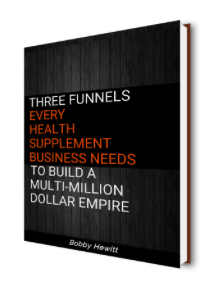When people encounter a contrarian perspective they usually shut down from all learning and growth. Unfortunately, this also happens in the world of marketing, and we can see this if we look no further that the divide between direct response marketing and the traditional e-commerce chief marketing officer.
Yet when looking at companies like Onnit, one of the most innovative brands in the health industry, their Chief Marketing Officer (CMO) Mike Spadier said one of the key’s to their success is inspiration and cross discipline learning.
On the one side, the direct response marketer is focused squarely on driving trackable revenue and the e-commerce marketer is focused on engagement (with metrics like Click Through Rate, Views, Likes, Shares, Reach, etc.) in addition to staying on brand, and metrics around sales and revenue.
It’s the idea of cross discipline learning where traditional e-commerce marketers can learn a lot from the direct response marketing approach, despite their different perspectives
In this article, we’ll look at the top 4 principals that an e-commerce store can learn and apply from direct response marketers, but there are many more.
Let’s get started with the first core principal…
Funnels vs. Shopping Carts
The traditional e-commerce website is a “choose your own adventure” journey where the visitor can browse your store to find something to buy, which is the complete opposite of the first principal of direct response.
In the direct response world this is done using funnels, as opposed to category pages and shopping carts.
Unlike product category pages which let you shop around. Funnels target a single specific product landing page, with one call to action usually taking you to an order page and then adding on up-sells like — One Time Offers (OTO’s) or One Click up-sells as stand alone pages after the buyer has entered their credit card information. In the e-commerce world, marketers use cross-sells which are by far less powerful because they don’t leverage the psychology used in one click up-sells.
But, it’s not just the experience that is different from e-commerce, it’s the economics as well.
The economics of a funnel is designed to drive up the average order value on the day of the first transaction, whereas an e-commerce shopping experience is designed for exploration. This is likely due to marketers trying to mimic the experience of retail and not approaching the problem from a blank slate.
A direct response funnel allows you to breakeven on your advertising spend on day one, which means your advertising pays for itself immediately. And as a result your advertising budget becomes infinite, which enables you to bring in thousands of buyers a day vs. hundreds.
Premiums and Bonuses
If you can increase the value of the offer in the mind of the prospect you can tip the scales towards an easier buying decision.
Which brings us to…
Traditional e-commerce companies are missing a huge opportunity by just offering the product. It seems that the most creative they get is adding free shipping. But direct response, marketers seem to have way more creativity when it comes to the offer structure. They consistently use premiums, often times called bonuses, that are added to an offer to increase the perceived value.
In the beauty market, traditional retail marketers add bonuses all the time yet it’s a practice rarely seen in traditional e-commerce. You’ll often see this for perfume where the retailer gives you a free gift with purchase.

But premiums don’t have to be physical items, they can be in a digital format like a PDF report, or an MP3 audio interview or even access to group coaching or one-on-one consultation sessions. They key is that they add value to the core purchase.
Long Form vs. Short Form
Traditional e-commerce product detail pages are all short pages, with the product and offer right up top above the fold. These pages usually focus only on the product benefits in a bulleted list format. Here’s what you get and how much it costs, with a short product description and some customer reviews. This leads the visitor to make a more logic based purchase decision, forcing the prospect to shop based on price. It’s no wonder then that so many online shoppers visit Amazon after they visit an e-commerce site.
But in direct response marketing, the length of the page is not such a sacred cow, which leads to…
The opposite of a traditional e-commerce product detail page is a direct response sales letter. Which are usually really, really, really long as compared to e-commerce sales pages and don’t reveal the product until half way or almost at the end of the page, which is roughly 5,000 pixels long or more in many cases.
What do direct response marketers know that traditional e-commerce marketers don’t?
It’s simple, people are not rational and they make all decisions, including buying decisions, based on emotion and then justify their decisions with logic.
So, with a Long Form Sales Letter (LFSL) direct response marketers have a chance to build their case and explain the value. They lean on the problem rather than the solution. Which adds emotional pull towards buying the product as the solution vs. a take it or leave attitude of e-commerce sites.
These types of direct response sales pages let you do that by creating a linear flow to the “story” of why you should buy, keeping the prospects “head down”, to focus on the sale.
In addition to allowing more space to build a cohesive case towards buying your product using evidence and proof, as well as story telling, emotion driven headlines, product demonstrations, and much, much more.
Backend vs. Frontend
The direct response marketer would bring in a buyer on the front end with a single product, single offer, single funnel and then treat the e-commerce catalog of products as the backend.
But, in order to understand that, you’ll need to understand this next principal…
You need to first start with the difference between the backend and the frontend.
Backend sales are those sales that are made to an existing customer. In other words the customer has already made an initial purchase from you, and is buying again.
Front end sales are those sales that are made to a brand new customer, who has never bought from you before.
In direct response marketing the economics are such that you’re acquiring customers at zero cost, where as in e-commerce you’re likely loosing money to get that same prospect to buy and then hoping to make it up on the backend.
Where the direct marketer really shines above the traditional e-commerce marketing counterpart is in the backend email follow up sequence, which includes the frequency, sophistication and segmentation of that email sequence to get existing customers to buy again and again.
Some of the tactics that direct response uses includes sending out different follow up emails to: those that didn’t open an email, those that opened but didn’t click, and those that clicked but didn’t buy. In addition to segmenting the offers in the emails based on Recency, Frequency an Monetary (RFM) metrics from the buyers activity. This technique breaks down quantitatively which customers are the best ones by examining how recently a customer has purchased (recency), how often they purchase (frequency), and how much the customer spends (monetary). Then crafting very specific offers and funnels for those different types of customer segments.
Are you beginning to see how traditional e-commerce marketers can take better advantage of direct response marketing techniques?
There’s a Lot To Learn
One fear many chief marketing officers have is about their brand, being tarnished but… If you take the best of e-commerce and the best of direct response, it is completely possible to optimize for a great brand experience and at the same time maximize sales using direct response strategies like…
- Breaking even on day one and acquiring a new customer with a direct response funnel, which leads to infinite ad budget, can and does bring in thousands vs hundreds of buyers a day. E-commerce companies typically have a huge backend, which means there are hundreds of opportunities to segment and monetize buyers.
- Adding value to the offer, by building in premiums and bonuses gives the e-commerce marketer more opportunities than the standard discounting and coupons, helping them to more away from a price war race to the bottom.
- And finally, selling based on emotion is what is at the heart of good sales and decision making in general. People are not rational decision makers. All decisions, including buying decisions, are based on emotion and then justified with logic.
So, just like oil and vinegar traditional direct response marketing and traditional e-commerce can go well together if you’re open minded.
Discover the 3 funnels that can help your health supplement business succeed.

Listen to the Health Supplement Business Mastery Podcast for for dietary supplement entrepreneurs and marketers.





Thank you so much for posting this. I think this really puts things into a different light. I mean, I have read about this stuff before but the way you write just makes it clearer, if that makes sense
Thanks Brian, you made my day. 🙂